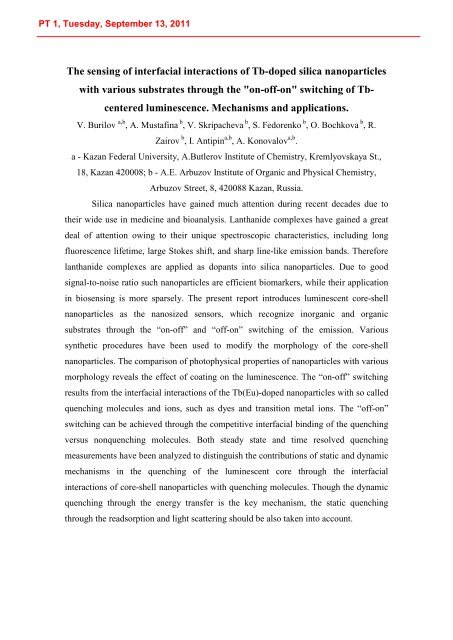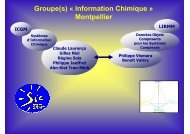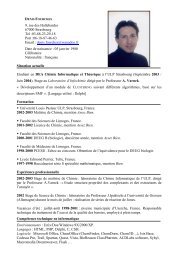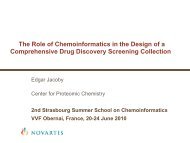International Summer School PROGRAM - Laboratoire d'Infochimie ...
International Summer School PROGRAM - Laboratoire d'Infochimie ...
International Summer School PROGRAM - Laboratoire d'Infochimie ...
You also want an ePaper? Increase the reach of your titles
YUMPU automatically turns print PDFs into web optimized ePapers that Google loves.
The sensing of interfacial interactions of Tb-doped silica nanoparticles<br />
with various substrates through the "on-off-on" switching of Tb-<br />
centered luminescence. Mechanisms and applications.<br />
V. Burilov a,b , A. Mustafina b , V. Skripacheva b , S. Fedorenko b , O. Bochkova b , R.<br />
Zairov b , I. Antipin a,b , A. Konovalov a,b<br />
.<br />
a - Kazan Federal University, A.Butlerov Institute of Chemistry, Kremlyovskaya St.,<br />
18, Kazan 420008; b - A.E. Arbuzov Institute of Organic and Physical Chemistry,<br />
Arbuzov Street, 8, 420088 Kazan, Russia.<br />
Silica nanoparticles have gained much attention during recent decades due to<br />
their wide use in medicine and bioanalysis. Lanthanide complexes have gained a great<br />
deal of attention owing to their unique spectroscopic characteristics, including long<br />
fluorescence lifetime, large Stokes shift, and sharp line-like emission bands. Therefore<br />
lanthanide complexes are applied as dopants into silica nanoparticles. Due to good<br />
signal-to-noise ratio such nanoparticles are efficient biomarkers, while their application<br />
in biosensing is more sparsely. The present report introduces luminescent core-shell<br />
nanoparticles as the nanosized sensors, which recognize inorganic and organic<br />
substrates through the “on-off” and “off-on” switching of the emission. Various<br />
synthetic procedures have been used to modify the morphology of the core-shell<br />
nanoparticles. The comparison of photophysical properties of nanoparticles with various<br />
morphology reveals the effect of coating on the luminescence. The “on-off” switching<br />
results from the interfacial interactions of the Tb(Eu)-doped nanoparticles with so called<br />
quenching molecules and ions, such as dyes and transition metal ions. The “off-on”<br />
switching can be achieved through the competitive interfacial binding of the quenching<br />
versus nonquenching molecules. Both steady state and time resolved quenching<br />
measurements have been analyzed to distinguish the contributions of static and dynamic<br />
mechanisms in the quenching of the luminescent core through the interfacial<br />
interactions of core-shell nanoparticles with quenching molecules. Though the dynamic<br />
quenching through the energy transfer is the key mechanism, the static quenching<br />
through the readsorption and light scattering should be also taken into account.









